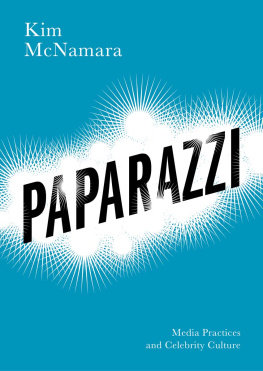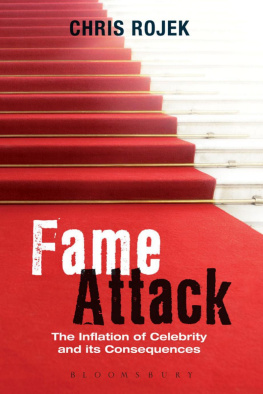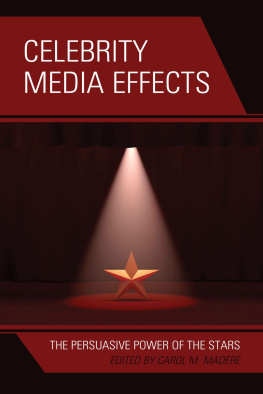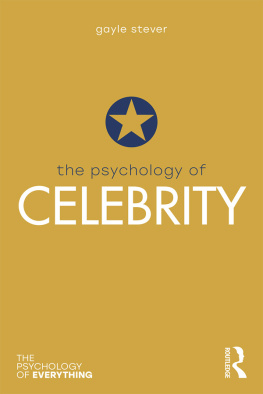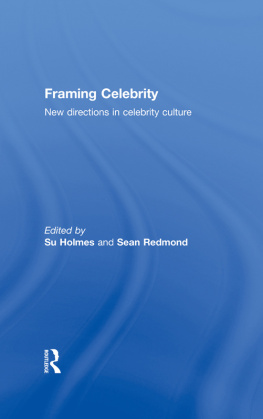Introduction
To explain why the lives of famous people such as Rihanna, Madonna, David Beckham, Kate Middleton, Kareena Kapoor, Jennifer Lawrence, One Direction, or Miley Cyrus have such a cultural impact, James Houran, Samir Navik, and Keeli Zerrusen concluded that the worldwide popularity of celebrities indicate that nearly everyone enjoys temporary escapism associated with the fantasy of celebrities (2005: 238). As indicated by this quote, we use celebrity to enhance our lives, whether in the form of fandom of admiring and gaining pleasure from the talents, styles, and unique qualities of famous individuals, or from just loving to hate particular figures. Thus, celebrity matters, and the idea of a worldwide celebrity presence is a key aspect of the cultural and media landscape of contemporary society. From film and rock/pop stars, to political figures, Reality TV contestants, celebrity-bloggers-turned celebrity figures, fans reaching YouTube millions with their bedroom-shot emotional celebrity-defences, to chefs, criminal figures, ice road truckers, and beauty pageant participants, the representation, possession, and quest for fame is more pervasive than ever.
But it always has been, as Leo Braudy (1986) demonstrates within his seminal history of fame within Western society, The Frenzy of Renown, in which he charts the desire to be publicly recognized as stemming from the ancient civilizations of Greece and Rome, through the rise of Christianity and the veneration of saints and prophets, through to the fame of monarchs, artists, poets, political figures and, ultimately, the democratic era of widespread fame produced by the rise of mass communication technologies and best epitomized by Hollywood. Therefore, the desire for fame and a compulsion to stand out from the social multitude is as old as human society itself.
The concept of fame, especially in relation to concepts such as stardom, is a particularly limited status as stars are comparatively rare due to their extraordinary quality. As such, it is figures, from Marlon Brando, Marlene Dietrich, Marilyn Monroe, John Wayne, Elizabeth Taylor, Jane Fonda, to Jack Nicholson, Bruce Willis, Tom Cruise, Julia Roberts, Angelina Jolie, George Clooney, Nicole Kidman, Matt Damon, Brad Pitt, Will Smith, or Sandra Bullock, who constitute the A-List conception of star (Dyer, 1982; McDonald, 2013), but who are comparatively rare. Indeed, the idea of the mediums that create stars being historically limited and stardom being quintessentially associated with cinema and originating with the Hollywood star system is a longstanding one (Gledhill, 1991; McDonald, 2000; deCordova, 2001).
In Martin Shinglers view, given the proximity of film stars to a range of other famous individuals, from popular music, sport stars and television personalities, the mark of the film star has been the primacy of performance in addition to issues such as glamour or photogenic physical attractiveness in essence, the perceived possession of distinctive and singular talent, rare ability, star image, and their work. However, there are instances in which this is not always so clear, for example prior to her Oscar-winning performance in Shakespeare In Love in 1996, Gwyneth Paltrow was notable as a celebrity figure rather than as an actress due to her relationships with Brad Pitt and Ben Affleck in addition to the multiple times her image consistently adorned the cover of celebrity and fashion magazines such as Vogue, Elle, Cosmopolitan, and Marie Claire (2012: 58). The example of Paltrow points to a differentiation between the concepts of stardom and celebrity, and it is a distinction that is essential to make as they are not the same categories, and indeed, fame and the concept of celebrity, while frequently overlapping, are ultimately unique. In this regard, Robin D. Barnes provides a cogent differentiation between fame and celebrity:
Fame has traditionally been associated with individual demonstrations of superior skill or striking deeds as displayed by a select few, then chronicled by contemporary authors and historians. Celebrity, on the other hand, is more transient, relying on marketing, timing, and instant appeal. (2010: 19)
Consequently, in conjunction with a literature devoted to stardom and fame, a distinctive body of academic research has become established to chart the nature and multidimensional historical, cultural, and social contours of celebrity (Monaco, 1978; Gamson, 1994; Gabler, 1995; Marshall, 1997; Rojek, 2001, 2012; Turner, 2004, 2014; Cashmore, 2006; Inglis, 2010; Ferris and Harris, 2011; Redmond, 2014). Ultimately, while the possessors of superior skills or striking deeds frequently do make it into the ever-expanding pantheon of celebrity culture, the semantic difference is essential to make as celebrity admits a far wider array of figures than the more laudable definition of fame allows. While the film stars rise to fame is built upon the honing of a craft coupled with potentially years of making it, celebrity consists of individuals who range from those who have produced pop hits (or had pop hits produced for them), established themselves as televisual personalities, write books, enter politics, model clothes, appear as themselves within Reality TV, broadcast their thoughts from their bedrooms to global audiences via YouTube, become embroiled in sex scandals, or commit heinous, but judiciously media-covered, crimes (while in some cases merely being related to a famous person is enough to warrant media attention). Many celebrities possess talent and unique skills or looks, but talent and achievement is not mandatory and, for the more cynically-inclined critics, image is now everything and merit frequently secondary within a landscape in which the exorbitance of celebritys contemporary cultural visibility is unprecedented (Turner, 2014: 4).


